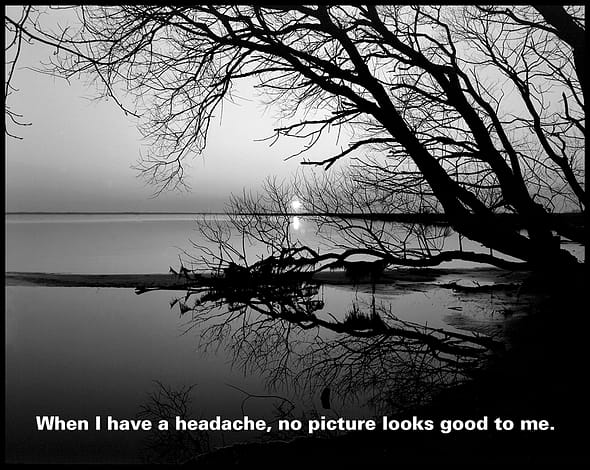From a Series of One Acts…

From a Series of One Acts… #8
From the mid-1980s until the early 1990s, I made a series of photographs connected more by an opportunity to play with ideas than any one specific concept. I saw each of these images as “one acts.” Often remixing tag lines from advertisements and juxtaposing the text directly on photographs I’d taken (often for no other reason other than I liked the scene), I was able to extend the meaning of these images.
This formula symbolizes my basic philosophy about art making: A + B = C. Mix one disparate idea with another, and you come up with a different experience than either of the individual parts (image or text) might convey.
By the time I began work on these images, my life experiences and ideas of what it meant to be an artist began to loosen. As a graduate student in photography and graphic design in the mid-1970s with no prior experiences as an artist (I had just gotten my BA in Political Science), I spent much of those years concerned about what it meant to be an artist. Where did my ideas come from, and would I someday run out of them? Most artists can relate to my early angst and insecurities. Poet and novelist Rainer Maria Rilke’s Letters to a Young Poet was my guide.
But, by the 1980s, I began to let go of those concerns. When I realized that I got my ideas from observing the world around me, I knew that I’d never run out of things to say as long as I remained curious. My previous work documenting the building of Los Angeles’ “last freeway,” the 105 (In Our Path), had been instrumental in showing me I was willing to take chances and engage with others through my work. Now it was time to play seriously.
While this playing released me from constraints I’d felt early on, there were significant issues I wanted to explore: the art world and art market, politics, immigration, feminism and my relationship to it, and photography itself. Also, it gave me a chance to take the early experiences I had as a child and connect them with more universal feelings we have as adults. And, sometimes, I just liked what I saw in front of my camera.
Every once in a while, years after making a piece, the work comes back to you in an entirely different way. This happened with the images I made of a secondhand store in the Fells Point section of Baltimore in the early 1990s. I was attracted to its handmade sign, “Nomenclatures.” It seemed like an odd name for a store like that. So, I took a photo, not knowing exactly what I’d do with it, if anything.
Originally, I had placed an entirely different story onto the image. It appeared in a one person exhibition I had in a Baltimore gallery and was used in a review of the show. Decades later, I received a call at work. It was from the daughter of the man who owned the store. She was cleaning out her father’s house after he had died and found a copy of the review in one of her father’s drawers. Through our conversation, we were able to connect many dots. And I ended up writing an essay about it: The Story of a Photograph That Changed Over Time. This is the true power of photography.
Here are a few images from this series. Click on any photo to view a larger version.

















